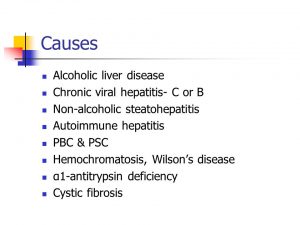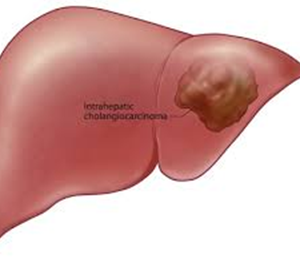Liver Disease Causes
 Infection: Various infections can cause liver disease, the most common types are hepatitis viruses such as Hepatitis A, B, C & E
Infection: Various infections can cause liver disease, the most common types are hepatitis viruses such as Hepatitis A, B, C & E
Chronic Alcohol Abuse: Most common cause of liver cancer and indication for transplant
Fatty Liver: Common causes are obesity, hypertriglyceridemia, diabetes
Immune system abnormality: Examples include Autoimmune hepatitis, Primary sclerosing cholangitis, Primary biliary cirrhosis
Other Causes: Drugs and Toxins, Genetics
Risk Factors: Following factors may
increase your risk for Liver problem
- Alcohol Abuse
- Diabetes
- Obesity
- Exposure to certain toxins or chemicals
- Unprotected sex
- Injecting drugs using shared needles
- Blood transfusion
Symptoms
- Yellowish discoloration of skin and eyes (Jaundice)
- Nausea & Vomitting
- Chronic Fatigue
- Pruritus / Itching
- Abdomen pain and distension (Ascites)
- Swelling or edema in the ankle and leg
- Dark colored urine
- Pale stools
- Loss of appetite
- Blood in the vomitus (Hematemesis)
- Fresh blood in the stool (Hematochezia) or Black tarry stools (melena)
Treatment
Treatment varies from life-style modifications to drugs to surgery depending on the specific cause. Changes in life-style include stopping alcohol use, regular exercise, diabetes and weight control for fatty liver, Chronic liver damage is managed conservatively with drugs initially and Liver transplant for end stage liver problem
Liver Disease Prevention
Healthy life style with regular exercise and weight management is must for healthy liver. Diabetes control. It is predicted that Fatty liver will be the leading cause of liver failure and liver cancer in future. Avoid alcohol intake and smoking. Hepatitis B vaccine is available. Unprotected sex, infected blood transfusion, sharing infected needles are risk for hepatitis infection and should be avoided
Hepatocellular Cancer / Liver Cancer
It is the most common primary malignant liver tumor; Occur after the age of 50 year and incidence is more common in male patient; In 80% of cases it occur under the background of chronic hepatic disease while in another 20% it occur in normal liver background. The 5 year survival rate of these patients is very dismissal approx. only 12%. It is the reason, primary prevention is the best strategy against hepatic cancer
Causes: The common causes of chronic hepatic disease in these patients are Alcohol, Hepatitis B & C infection and Steatohepatitis. HBV infection can cause liver cancer in the absence of cirrhosis.
Prevention:Hepatitis B vaccine is available and every new born should be immunized immediately after birth. Treatment is available for Hepatitis B & C infection. High risk person to these infections should be tested and if +ve, treatment should be started. Infact Hepatitis C infection is one of the few viral infection which is curable. Excessive alcohol intake should be discouraged. Environmental toxins should be avoided. Maintain a healthy weight, do regular exercise, control diabetes to prevent from fatty liver. As the incidence of obesity is increasing, it is estimated that it can be the leading cause of liver failure and hepatic cancer in next decade if not controlled now
Symptoms: One of the early sign of Hepatocellular cancer or liver cancer is sudden decompensation in patients of cirrhosis who were otherwise stable; These patients may develop jaundice, new onset or refractory ascites. Patient with normal liver generally present with right upper abdomen pain along with anorexia & weight loss
Diagnosis: Imaging modality of choice for diagnosis is triple phase CT abdomen which reveals typical arterial enhancement and portal venous phase washout of lesion. Tumor marker is alpha-fetoprotein; Typical feature on CT along with raised alpha-fetoprotein is sufficient for diagnosis of hepatic Cancer; FNAC is not done because of risk of seedling of needle tract. However FNAC is done in non-cirrhotic patients
Treatment: It is complicated by the fact that in 80% it occur in diseased liver, so while planning any treatment options we have to consider the liver condition & tumor characteristics
If the patient is listed for liver transplant because of cirrhosis and develops liver cancer than transplant is the only option. It will take care of underlying liver condition and cancer also
In early cirrhotic patients with well controlled disease who at present does not require transplant, Surgical resection is a good option
If Surgical resection is not possible or patient is not fit for surgery then there are various non-surgical methods available which should be done according to the criteria fulfilled

Intrahepatic Cholangiocarcinoma
It is generally of two types one is pyogenic and other is Amoebic, Most commonly patients present with fever and right-sided upper abdomen pain; Ultrasound abdomen is the first investigation in pain abdomen which will suggest the diagnosis, it will tell number and size of the abscess, whenever in doubt triple phase CT abdomen should be done because many times other hepatic pathology may be misdiagnosed , Once diagnosed appropriate antibiotics should be started, At initial stage abscess are solidified so Percutaneous drainage will not be effective, so in case of large abscess once it is liquified PCD can be done, Sometimes patient present with features of ruptured hepatic abscess such as diffuse pain abdomen, high grade fever in these cases Laparoscopic peritoneal lavage with abscess drainage should be done.

